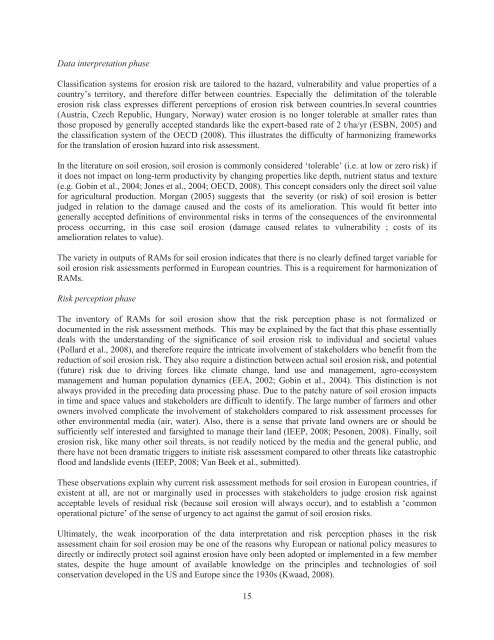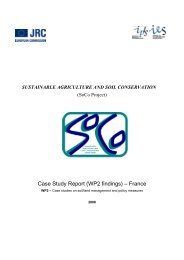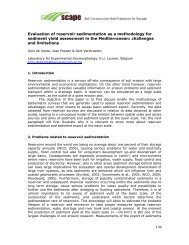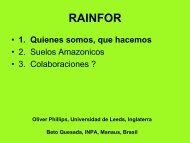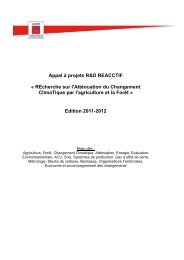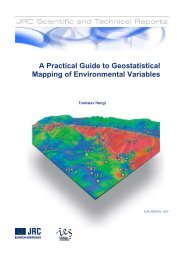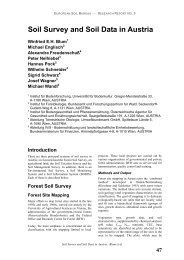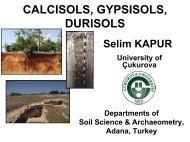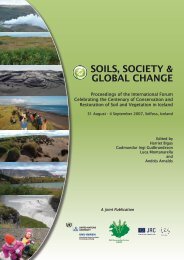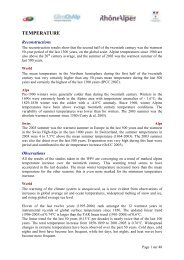Risk Assessment Methodologies of Soil Threats in Europe
Risk Assessment Methodologies of Soil Threats in Europe
Risk Assessment Methodologies of Soil Threats in Europe
Create successful ePaper yourself
Turn your PDF publications into a flip-book with our unique Google optimized e-Paper software.
Data <strong>in</strong>terpretation phase<br />
Classification systems for erosion risk are tailored to the hazard, vulnerability and value properties <strong>of</strong> a<br />
country’s territory, and therefore differ between countries. Especially the delimitation <strong>of</strong> the tolerable<br />
erosion risk class expresses different perceptions <strong>of</strong> erosion risk between countries.In several countries<br />
(Austria, Czech Republic, Hungary, Norway) water erosion is no longer tolerable at smaller rates than<br />
those proposed by generally accepted standards like the expert-based rate <strong>of</strong> 2 t/ha/yr (ESBN, 2005) and<br />
the classification system <strong>of</strong> the OECD (2008). This illustrates the difficulty <strong>of</strong> harmoniz<strong>in</strong>g frameworks<br />
for the translation <strong>of</strong> erosion hazard <strong>in</strong>to risk assessment.<br />
In the literature on soil erosion, soil erosion is commonly considered ‘tolerable’ (i.e. at low or zero risk) if<br />
it does not impact on long-term productivity by chang<strong>in</strong>g properties like depth, nutrient status and texture<br />
(e.g. Gob<strong>in</strong> et al., 2004; Jones et al., 2004; OECD, 2008). This concept considers only the direct soil value<br />
for agricultural production. Morgan (2005) suggests that the severity (or risk) <strong>of</strong> soil erosion is better<br />
judged <strong>in</strong> relation to the damage caused and the costs <strong>of</strong> its amelioration. This would fit better <strong>in</strong>to<br />
generally accepted def<strong>in</strong>itions <strong>of</strong> environmental risks <strong>in</strong> terms <strong>of</strong> the consequences <strong>of</strong> the environmental<br />
process occurr<strong>in</strong>g, <strong>in</strong> this case soil erosion (damage caused relates to vulnerability ; costs <strong>of</strong> its<br />
amelioration relates to value).<br />
The variety <strong>in</strong> outputs <strong>of</strong> RAMs for soil erosion <strong>in</strong>dicates that there is no clearly def<strong>in</strong>ed target variable for<br />
soil erosion risk assessments performed <strong>in</strong> <strong>Europe</strong>an countries. This is a requirement for harmonization <strong>of</strong><br />
RAMs.<br />
<strong>Risk</strong> perception phase<br />
The <strong>in</strong>ventory <strong>of</strong> RAMs for soil erosion show that the risk perception phase is not formalized or<br />
documented <strong>in</strong> the risk assessment methods. This may be expla<strong>in</strong>ed by the fact that this phase essentially<br />
deals with the understand<strong>in</strong>g <strong>of</strong> the significance <strong>of</strong> soil erosion risk to <strong>in</strong>dividual and societal values<br />
(Pollard et al., 2008), and therefore require the <strong>in</strong>tricate <strong>in</strong>volvement <strong>of</strong> stakeholders who benefit from the<br />
reduction <strong>of</strong> soil erosion risk. They also require a dist<strong>in</strong>ction between actual soil erosion risk, and potential<br />
(future) risk due to driv<strong>in</strong>g forces like climate change, land use and management, agro-ecosystem<br />
management and human population dynamics (EEA, 2002; Gob<strong>in</strong> et al., 2004). This dist<strong>in</strong>ction is not<br />
always provided <strong>in</strong> the preced<strong>in</strong>g data process<strong>in</strong>g phase. Due to the patchy nature <strong>of</strong> soil erosion impacts<br />
<strong>in</strong> time and space values and stakeholders are difficult to identify. The large number <strong>of</strong> farmers and other<br />
owners <strong>in</strong>volved complicate the <strong>in</strong>volvement <strong>of</strong> stakeholders compared to risk assessment processes for<br />
other environmental media (air, water). Also, there is a sense that private land owners are or should be<br />
sufficiently self <strong>in</strong>terested and farsighted to manage their land (IEEP, 2008; Pesonen, 2008). F<strong>in</strong>ally, soil<br />
erosion risk, like many other soil threats, is not readily noticed by the media and the general public, and<br />
there have not been dramatic triggers to <strong>in</strong>itiate risk assessment compared to other threats like catastrophic<br />
flood and landslide events (IEEP, 2008; Van Beek et al., submitted).<br />
These observations expla<strong>in</strong> why current risk assessment methods for soil erosion <strong>in</strong> <strong>Europe</strong>an countries, if<br />
existent at all, are not or marg<strong>in</strong>ally used <strong>in</strong> processes with stakeholders to judge erosion risk aga<strong>in</strong>st<br />
acceptable levels <strong>of</strong> residual risk (because soil erosion will always occur), and to establish a ‘common<br />
operational picture’ <strong>of</strong> the sense <strong>of</strong> urgency to act aga<strong>in</strong>st the gamut <strong>of</strong> soil erosion risks.<br />
Ultimately, the weak <strong>in</strong>corporation <strong>of</strong> the data <strong>in</strong>terpretation and risk perception phases <strong>in</strong> the risk<br />
assessment cha<strong>in</strong> for soil erosion may be one <strong>of</strong> the reasons why <strong>Europe</strong>an or national policy measures to<br />
directly or <strong>in</strong>directly protect soil aga<strong>in</strong>st erosion have only been adopted or implemented <strong>in</strong> a few member<br />
states, despite the huge amount <strong>of</strong> available knowledge on the pr<strong>in</strong>ciples and technologies <strong>of</strong> soil<br />
conservation developed <strong>in</strong> the US and <strong>Europe</strong> s<strong>in</strong>ce the 1930s (Kwaad, 2008).<br />
15


